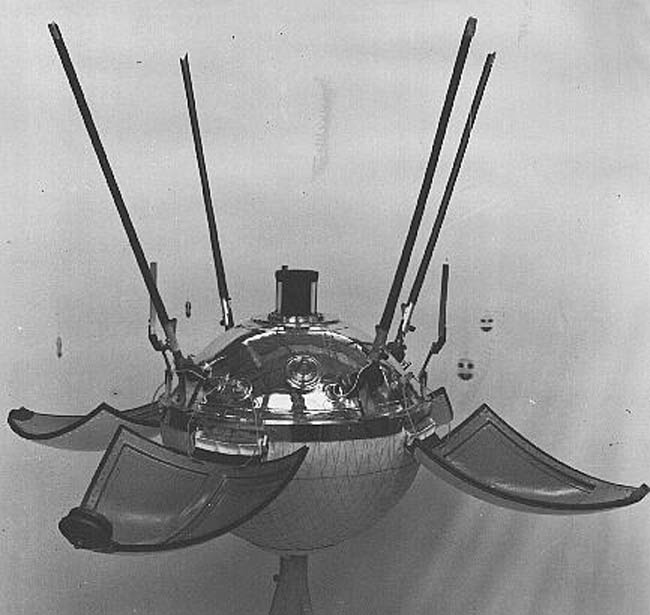Lunar Lost & Found: The Search for Old Spacecraft

One look at Earth's Moon is all it takes. It has been mussed up by scads of incoming celestial objects that produced lots of craters.
But our Moon has also been on the receiving end of artificial impacts over the last few decades. Moon probes and leftover rocket stages have contributed to the crater population-albeit too small to see from our planet. Robotic lunar landers from the United States and the former Soviet Union dot the Moon too.
Add in hardware castaways from human adventurers who made their way to the Moon from 1969 through 1972 as part of NASA's Apollo program, and you've got a lot of junk on the Moon.
Pinpointing old spacecraft and artificial impact craters is not only a curatorial courtesy, but also can generate important science.
That's the report from Philip Stooke, an associate professor within the department of geography at the University of Western Ontario in London, Ontario, Canada. Stooke described his lunar detective story in a paper released at the 37th Lunar and Planetary Science Conference (LPSC), held March 13-17 in Houston.
Precise locales
Starting in the 1960s, the "space race" between the Soviet Union and the United States was on full-speed. And the Moon was a place to demonstrate one-upmanship.
Breaking space news, the latest updates on rocket launches, skywatching events and more!
NASA's Ranger, Surveyor and Lunar Orbiter spacecraft set the stage for the piloted Apollo landers. For the Soviet Union, it was the robotic Luna-series that plowed into the desolate landscape, as well as soft-landed, roved around, and even shot samples back to Earth across cis-lunar space.
NASA's Lunar Reconnaissance Orbiter (LRO), to be sent moonward in 2008, will be able to spot some of this Space Age flotsam. LRO's camera system has enough resolving power for the task.
But there is uncertainty in targeting LRO's imaging hardware to scout out the precise locales of all that gear that has plopped down on the aged Moon.
Tighter coordinates
"I've devoted almost all my time in the last five years to my Atlas of Lunar Exploration, which is in the final stages now," Stooke told SPACE.com. Part of his research is focused on tracking down the whereabouts of decades-old mooncraft and identifying craters caused by human-made objects. One might think the locations would be well-charted.
But spacecraft were "lost" because they were never found initially, Stooke said. There are those craft that came to rest on the lunar surface, with their positions known to within about 6 or 12 miles (10 or 20 kilometers), figured out by tracking a spacecraft's signals during descent.
However, if future astronauts want to do a pinpoint landing near a piece of equipment, or wheel over to examine an old lander, they'll need much tighter coordinates.
In some instances, the imagery taken by landed spacecraft from the surface is a big help.
"That is also important for establishing the geological context of surface observations. So whenever something lands...people try to locate it precisely," Stooke pointed out. "The well established method for doing this is by comparing horizon relief features-hills or crater rims-on panoramas with the same features on orbital images. If you can match them you can locate the lander precisely."
Surveying for Surveyor
This method was basically invented, Stooke explained, by Ewen Whitaker of the Lunar and Planetary Laboratory at the University of Arizona in Tucson. He used it with Surveyor 1 and subsequent Surveyor craft that set down on the Moon between 1966 and 1968.
"But it does depend on being able to match features," Stooke added. "In very flat areas there may be nothing to match." Surveyor 5 is such a case.
"If you have only low resolution orbital images you may not be able to make a match either-that applies partly to Surveyor 5 as well, but especially to all the Soviet landers," Stooke said. "No Soviet spacecraft has ever been located precisely in this way because they didn't land in areas of good orbital photography."
Even with photos taken from the Moon's surface, questions can remain. For example, is the Soviet Luna 9 landing area on the Moon back in 1966 in mare or highland terrain? "The argument has continued since it landed," Stooke said.
Part of the interest is purely historical.
"It would be nice to know where Luna 9 is, the first successful lander," Stooke said. "We may want to set up a register of historic sites, not to be disturbed by future missions or hardware impacts. To do that we need accurate locations."
Search for Lunokhod
One nifty exercise that's now being considered is attempting to bounce a laser beam off a lost-on-the-Moon Soviet rover: Lunokhod 1. That eight-wheel robotic lunar buggy is outfitted with laser "retroreflectors" and rolled about within the Moon's Sea of Rains for nearly a year after landing in November 1970.
Lunokhod 1 may still have value as a laser ranging target. That's if it can be located precisely.
The Soviet machinery is sitting silent at the most northerly of all landings on the Moon to date, "and would be a vital part of understanding the Moon's exact rotation for geophysical purposes," Stooke said.
However, the robot's position is uncertain by at least 3 miles (5 kilometers), and stabs at getting laser returns all failed since early in the Lunokhod 1's mission.
"We don't know if it is still clean or oriented suitably...if not there's no hope. But if it is, we still need a good position," Stooke said.
Tantalizing target
"The recovery of Lunokhod 1 is on my wish list," said Jim Williams of the Jet Propulsion Laboratory (JPL) in Pasadena, California. He and fellow investigators are part of a Lunar Laser Ranging (LLR) data analysis group at JPL.
Williams told SPACE.com that there are four laser retroreflector arrays on the Moon that get ranged: the Apollo 11, 14, and 15 sites plus the other Russian moonbuggy, Lunokhod 2. "As a result of the ranging, we know those positions to better than one-meter accuracy" or roughly three feet, he said.
The arrays of 14 prisms on Lunokhods 1 and 2 were built by the French. The Lunokhod 2 retroreflector has been ranged, so the design works, Williams noted. The Lunokhod would rove during daylight, but was parked at night so that the array was oriented properly for Earth-to-Moon laser ranging.
Lunokhod 1 is a tantalizing target, Williams said.
"A few laser observations were reported early in the mobile Lunokhod 1's journey and later after it stopped moving, but those observations have never been publicly distributed or processed with a data analysis program of modern accuracy," Williams explained. "It is unclear whether the effectiveness of the Lunokhod 1 array has been compromised or whether position uncertainty and weak signal conspired to prevent its acquisition by standard ranging stations...but a modern search is in order."
Apache Point Observatory
The sole U.S. LLR station in the early 1970s tried to range Lunokhod 1, Williams said, but did not find it.
"The task is more difficult than it sounds," Williams said. "The return signal should be very weak and only a limited spread of distance and angle could be searched...for a sequence of shots. The position may have been too poor or the Lunokhod 1 retroreflector may be obscured somehow."
There is a new LLR station now undergoing checkout at Apache Point Observatory in New Mexico.
"Once the new station is operational and returning data, then a Lunokhod 1 search will be practical," Williams said. This new equipment at the facility will be a good instrument for the search, he added, but will still require a major effort.
Location uncertainties
Meanwhile, Stooke is on the lunar lookout trail.
Early Apollo Moon landing craft and the moonwalkers themselves scuffed up areas of the lunar surface. These disturbances are visible in orbital imagery taken by later Apollo missions.
A number of discarded Apollo rocket stages and lunar module ascent stages were tracked to narrow the search area. So those which fell in areas subsequently imaged were identified fairly easily, Stooke reported in his LPSC paper.
Ranger 6's impact area may now have been found in Clementine images taken by that U.S. Defense Department Moon-orbiting spacecraft in 1994, Stooke stated. On the other hand, many impact craters made by orbiters at the end of their missions-or by failed landers-will be difficult to find because of location uncertainties.
NASA Lunar Orbiter impact sites, for example, are uncertain by hundreds of kilometers and would be very difficult to distinguish from natural fresh impacts.
On the other hand, craters formed by camera-carrying Ranger probes were found easily because images taken during their plunge toward the lunar terrain allowed impact sites to be predicted. Two of the three successful kamikaze-like Ranger missions imaged their impact points for comparison with later images.
Hiten, a Japanese lunar orbiter, should be located easily using Earth-based tracking data and observation of the impact, Stooke said.
Protection of sites
In his lunar work, Stooke noted that several challenges remain.
Can the site of Russia's Luna 2 impact be located? If it is, will visual observers be vindicated after years of doubt? Can Luna 9 or Surveyor 5 be located at last? Can the craters caused by the hits of spent rocket stages from the Apollo 15, 16 and 17 missions be found?
"The scientific value of this work includes placing lander data in better context, refining seismic results from Apollo [rocket stage] impacts, or planning future visits to old sites for study of old hardware, as Apollo 12 did for Surveyor 3," Stooke says. "If in the future it is decided to confer special designations or protection on these sites, finding them is essential."
This article is part of SPACE.com's weekly Mystery Monday series.
- Lunar Reconnaissance Orbiter
- Top 10 Apollo Era Moon Discoveries
- Moon Holds Earth's Ancient Secrets
- Apollo Moon Rocks: Dirty Little Secrets
- Skywatcher's Guide to the Moon
Join our Space Forums to keep talking space on the latest missions, night sky and more! And if you have a news tip, correction or comment, let us know at: community@space.com.

Leonard David is an award-winning space journalist who has been reporting on space activities for more than 50 years. Currently writing as Space.com's Space Insider Columnist among his other projects, Leonard has authored numerous books on space exploration, Mars missions and more, with his latest being "Moon Rush: The New Space Race" published in 2019 by National Geographic. He also wrote "Mars: Our Future on the Red Planet" released in 2016 by National Geographic. Leonard has served as a correspondent for SpaceNews, Scientific American and Aerospace America for the AIAA. He has received many awards, including the first Ordway Award for Sustained Excellence in Spaceflight History in 2015 at the AAS Wernher von Braun Memorial Symposium. You can find out Leonard's latest project at his website and on Twitter.
